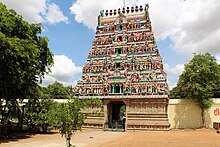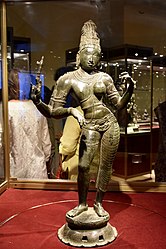
Vaitheeswaran Koil is a Hindu temple dedicated to the Shiva, located in the Indian state of Tamil Nadu. Shiva is worshipped as Vaidyanathar or Vaitheeswaran meaning the "God of healing" and it is believed that prayers to Vaitheeswaran can cure diseases. Vaitheeswaran is a Tamil derivative from vaidya (Doctor) and Ishvara (God/Master). The presiding deity is Sri vaidyanathan, facing towards West whereas East side is the common one. He is the God of Healing. When pronouncing in Tamil, it sounds like "vaideeswaran". It is one of the nine Navagraha temples and is associated with the planet Mars (Angaraka).

Suryanar Kovil is a Hindu temple dedicated to the deity Hindu Sun-God, Surya, located in Suryanar Kovil, a village near the South Indian town of Kumbakonam Thanjavur District in Tamil Nadu, India. The presiding deity is Suriyanar, the Sun and his consorts Ushadevi and Pratyusha Devi. The temple also has separate shrines for the other eight planetary deities. The temple is considered one of the nine Navagraha temples in Tamil Nadu. The temple is one of the few historic temples dedicated to Sun god and is also the only temple in Tamil Nadu which has shrines for all the planetary deities.

Thenupuriswarar Temple is a Hindu temple dedicated to the god Shiva located in the holy village of Patteeswaram, Tamil Nadu, India. Shiva is worshiped as Thenupuriswarar, and is represented by the lingam. His consort Parvati is depicted as Nyanambikai (Somakamalambigai). The presiding deity is revered in the 7th century Tamil Saiva canonical work, the Tevaram, written by Tamil saint poets known as the Nayanars and classified as Paadal Petra Sthalam. The temple is associated with the legend of Sambandar to whose view Nandi moved to have a direct view of the presiding deity. Muthupandal festival celebrated in the temple in associated with the legend.
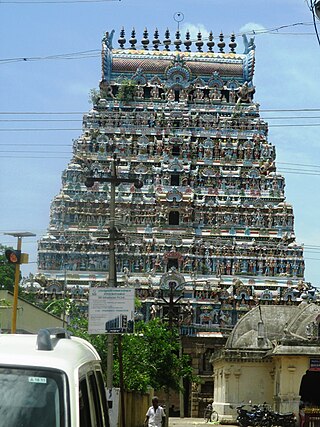
Mahalingeswaraswamy Temple, Thiruvidaimarudur is a Hindu temple dedicated to the deity Shiva, located in Tiruvidaimaruthur, a village in the South Indian state of Tamil Nadu. It is significant to the Hindu sect of Saivism as one of the seven major Shiva temples. Shiva is worshiped as Mahalingeswaraswamy, and is represented by the lingam, with his idol referred to as Jyothirmayalingam. His consort Mookambika is depicted as Devi Bruhatsundarakuchaambika or Bruhatsundarakuchaambigai amman. The lingam of the temple is believed to be the focal point for the seven consorts of Shiva. The presiding deity is revered in the 7th century Tamil Saiva canonical work, the Tevaram, written by Tamil poet saints known as the nayanars and classified as Paadal Petra Sthalam. The 9th century Saiva saint poet Manikkavacakar has sung praise about the temple in his works. Pattinattar, one of the revered saints visited this shrine many times.

Sattainathar temple, Sirkazhi is a Hindu temple dedicated to Shiva located in Sirkali, Tamil Nadu, India. The temple is incarnated by the hymns of Thevaram and is classified as Paadal Petra Sthalam. It is an ancient temple complex with three different Shiva shrines in three stories.

Aiyarappar is a Hindu temple dedicated to Shiva located in the village of Tiruvaiyaru, Tamil Nadu, India. Shiva is worshiped as Aiyarappar, and is represented by the lingam and his consort Parvati is depicted as AramValarthaNaayagi. The presiding deity is revered in the 7th century Tamil Saiva canonical work, the Tevaram, written by Tamil poet saints known as the nayanars and classified as Paadal Petra Sthalam.

Palaivananathar Temple is a Hindu temple dedicated to the deity Shiva, located in Papanasam, in Thanjavur district in the South Indian state of Tamil Nadu. Shiva is worshiped as Papanasanathar, and is represented by the lingam. His consort Parvati is depicted as Thavalavennayagal. The presiding deity is revered in the 7th century Tamil Saiva canonical work, the Tevaram, written by Tamil saint poets known as the Nayanars and classified as Paadal Petra Sthalam.
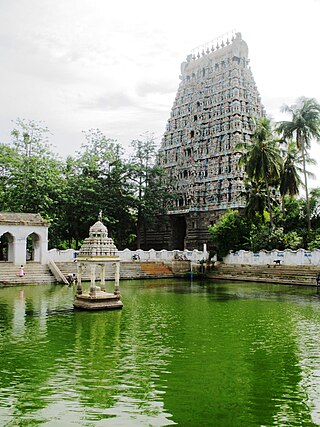
Mayuranathaswamy Temple, Mayiladuthurai or Mayuranathar Temple is a Hindu temple in the town of Mayiladuthurai in Tamil Nadu, India. The temple is dedicated to Lord Mayuranathaswamy, a form of Shiva, and has given its name to the town itself. The main icon is a lingam and the presiding deity is called Mayuranathar because the Hindu goddess Parvathi worshipped Shiva here in the form of a mayura.
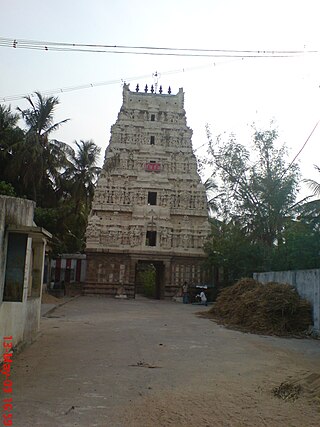
Anbil Alanthurai Temple is a temple dedicated to Shiva, located on the banks of the Kollidam river in Anbil, a small village near Lalgudi. is a Hindu temple dedicated to Shiva located in the village of Tiruchotruthurai, Tamil Nadu, India. Shiva is worshiped as Sathyavaheeswarar, and is represented by the lingam and his consort Parvati is depicted as Soundaranayagi. The presiding deity is revered in the 7th century Tamil Saiva canonical work, the Tevaram, written by Tamil poet saints known as the nayanars and classified as Paadal Petra Sthalam.

Prananadeswarar Temple is a Hindu temple dedicated to Shiva located in Thirumangalakudi in Mayiladuthurai district of Tamil Nadu, India. Shiva is worshiped as Prananatheswarar, and is represented by the lingam and his consort Parvati is depicted as Mangala Nayagi. The presiding deity is revered in the 7th century Tamil Saiva canonical work, the Tevaram, written by Tamil poet saints known as the nayanars and classified as Paadal Petra Sthalam.

Pushpavananathar Temple is a Hindu temple dedicated to Shiva located in the village of Tiruppoonturutti near Tiruvaiyaru, Tamil Nadu, India. Shiva is worshiped as Aiyarappar, and is represented by the lingam and his consort Parvati is depicted as Soundaranayagi. The presiding deity is revered in the 7th century Tamil Saiva canonical work, the Tevaram, written by Tamil poet saints known as the nayanars and classified as Paadal Petra Sthalam.

Vedapuriswarar Temple, Thiruvedhikudi or Vazhaimadunathar Temple is a Hindu temple dedicated to Shiva located in Thiruvedhikudi near Tiruvaiyaru, Tamil Nadu, India. The presiding deity is revered in the 7th century Tamil Saiva canonical work, the Tevaram, written by Tamil poet saints known as the nayanars and classified as Paadal Petra Sthalam. The temple is counted as the earliest of all Chola temples.
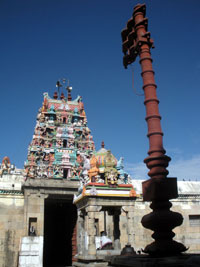
Kannayariamudayar Temple, Thirukkarayil is a Hindu temple dedicated to Shiva located in Thirukaravasal in Nagapattinam district of Tamil Nadu, India. Constructed in the Dravidian style of architecture, the temple is believed to have been built during the Cholas period in the 9th century. Shiva is worshipped as Kannayiranathar and his consort Parvathi as Kailasanayaki.

Pasupatheeswarar Temple, Avoor or Avoor Pasupatheeswaram is a Hindu temple dedicated to Hindu god Shiva, located in the village Avoor, located 12 km south of South Indian town, Kumbakonam, Tamil Nadu, India. The temple is one of the 70 madakoil built by 2nd century Chola king, Kochengat Chola. The temple is known for the Panchabairavar, the five images of Bhairavar. The temple is revered in the verses of Tevaram, the 7th century Tamil Saiva canon by Tirugnana Sambandar.
Nine Grahas Temples in Tamil Nadu is a set of nine Hindu temples, each dedicated to one of the nine planetary deities, the Navagraham in various places around the South Indian towns of Kumbakonam and Mayiladuthurai in Tamil Nadu, India. The presiding deity in most of the temples is Shiva, with a shrine dedicated to the planetary deity. Leaving Tirunallar Saniswaran Temple which is located in Karaikkal, all the other temples are located in Tamil Nadu.

Sathyanatheswarar Temple is a Hindu temple dedicated to Shiva, located in the town of Thirukalimedu, near Indira Theertham Kanchipuram, Kanchipuram district in Tamil Nadu, India. Shiva is worshipped as Sathyanatheswarar and his consort Parvathi as Pramarambikai. Sathyanatheswarar is revered in the 7th-century CE Tamil Saiva canonical work, the Tevaram, written by Tamil saint poets known as the nayanars and classified as Paadal Petra Sthalam, the 275 temples revered in the canon.
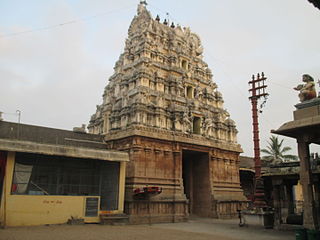
Veerateeswarar Temple in Tirukoilur, a panchayat town in Kallakurichi district in the South Indian state of Tamil Nadu, is dedicated to the Hindu god Shiva. Constructed in the Dravidian style of architecture, the temple is believed to have been built during the Cholas period in the 10th century. Shiva is worshipped as Veerateeswarar and his consort Parvathi as Periyanayagi.

Vaseeswarar Temple is a Hindu temple dedicated to the deity Shiva, located in Thirupasoor, a village in Tiruvallur district in the South Indian state of Tamil Nadu. Shiva is worshiped as Vaseeswarar, and is represented by the lingam. His consort Parvati is depicted as Pasupathinayagi. The temple is located on the Southern banks of Poondi reservoir on the Thiruvallur - Thiruthani road, 5 km (3.1 mi) away from the town. The presiding deity is revered in the 7th-century CE Tamil Saiva canonical work, the Tevaram, written by Tamil saint poets known as the nayanmars and classified as Paadal Petra Sthalam.

Vadukeeswarar Temple is a Hindu temple dedicated to the deity Shiva, located in Thiruvandarkoil, a village in Pondicherry - Villupuram highway in Pondicherry in the South Indian state of Tamil Nadu. Shiva is worshiped as Vadukeeswarar, and is represented by the lingam. His consort Parvati is depicted as Thiripura Sundari. The temple is located on the Chennai - Villupuram highway. The presiding deity is revered in the 7th century Tamil Saiva canonical work, the Tevaram, written by Tamil saint poets known as the nayanmars and classified as Paadal Petra Sthalam.

Pushpavaneswarar temple in Thirupuvanam, a town in Sivaganga district in the South Indian state of Tamil Nadu, is dedicated to the Hindu god Shiva. Constructed in the Dravidian style of architecture, the temple is believed to have been built during the Cholas period in the 7th century. Shiva is worshipped as Pushpavaneswarar and his consort Parvathi as Soundaranayagi.
